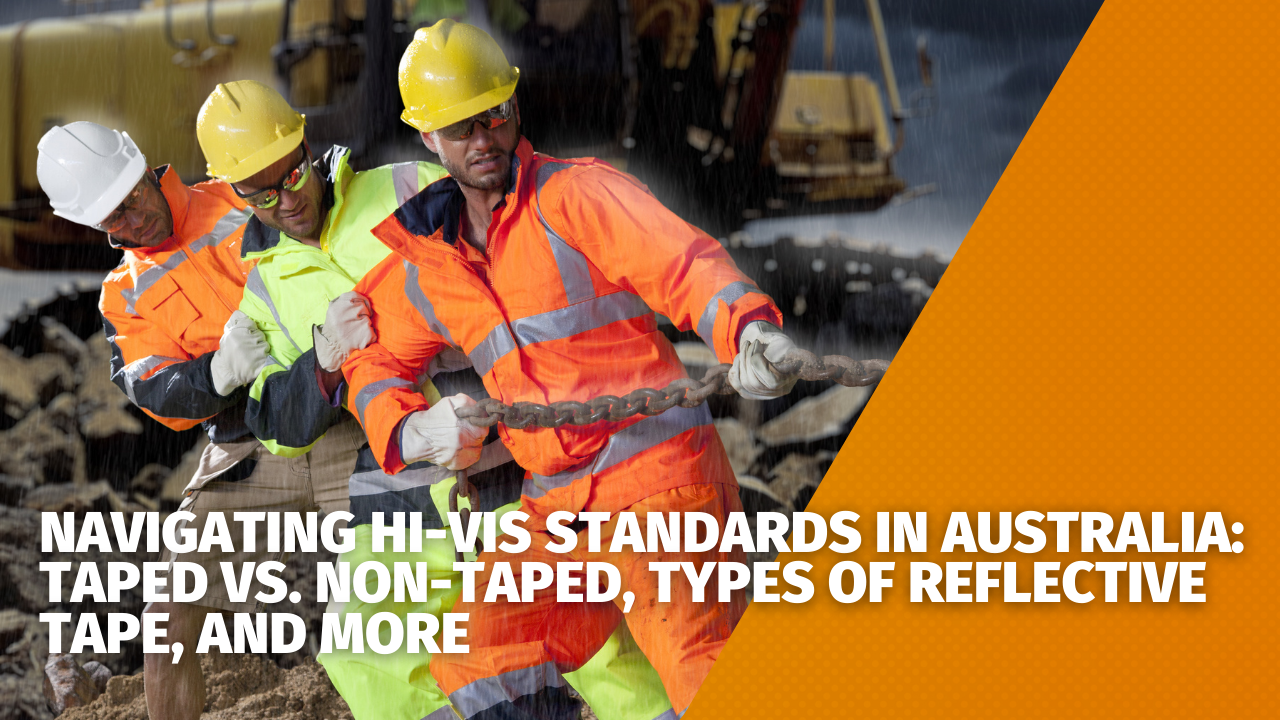In Australia, "Hi-Vis" is more than just a fashion statement; it's a crucial safety standard that protects workers in various industries. High-visibility clothing is designed to enhance the visibility of workers, especially in hazardous environments, to prevent accidents and ensure their safety.
Understanding Hi-Vis standards in Australia is essential for both employers and employees to ensure compliance and promote safety in the workplace.
This blog post will delve into the nuances of Hi-Vis standards, including the difference between taped and untaped garments, the various types of reflective tape, and other pertinent information regarding this crucial aspect of workplace safety.
Hi-Vis Standards in Australia
The need for Hi-Vis clothing in Australia arises from the diverse range of industries in which workers may be exposed to hazardous conditions. Hi-Vis clothing is mandated to reduce the risk of accidents in industries such as construction, mining, roadwork, and manufacturing. To ensure the effectiveness of Hi-Vis apparel, various standards have been established in Australia.
The primary standard for Hi-Vis clothing in Australia is AS/NZS 4602.1:2011. This standard sets guidelines for the design, performance, and materials used in high-visibility garments. It categorises Hi-Vis garments into different classes, each designated by a specific class number. These classes determine the minimum amount of visible material and the configuration of reflective tape required. Classifications for Hi-Vis clothing include Class D, Class N, and Class Day/Night.
Class D:
This class is designed for daytime use only and includes garments that do not have reflective tape. It provides basic visibility during daylight hours.
Class N:
Class N garments are intended for night use and feature reflective tape to improve visibility in low-light conditions. These garments are not suitable for daytime use.
Class Day/Night:
As the name suggests, Class Day/Night garments are suitable for both day and night use. They feature reflective tape for low-light conditions and provide good visibility during the day.

Taped vs. Non-Taped Hi-Vis Garments
One significant aspect of Hi-Vis clothing is the presence or absence of reflective tape. This tape plays a pivotal role in enhancing visibility, especially in low-light conditions. Let's explore the key differences between taped and non-taped Hi-Vis garments.
Taped Hi-Vis Garments:
Taped Hi-Vis garments, as the name suggests, include reflective tape strategically placed on the garment to maximise visibility. The tape reflects light, making the wearer more conspicuous to others. The presence of reflective tape is especially crucial in industries where workers are exposed to moving vehicles or machinery during low-light conditions.
The reflective tape on these garments is compliant with specific standards to ensure visibility meets safety requirements.
Non-Taped Hi-Vis Garments:
Non-taped Hi-Vis garments, on the other hand, do not feature reflective tape. They rely solely on the high-visibility colour of the fabric to make the wearer visible during daylight hours. While they meet Class D standards, non-taped garments are not suitable for night or low-light conditions when visibility is limited.
In summary, the choice between taped and non-taped Hi-Vis garments depends on the work environment and the time of day when they will be worn.
Taped Hi-Vis garments are essential for industries with nighttime work or low-light conditions, while non-taped garments are suitable for daytime use.
Types of Reflective Tape
Reflective tape is a crucial component of Hi-Vis garments, enhancing the visibility of the wearer. There are several types of reflective tape used in Hi-Vis clothing, each with specific features and benefits. Let's delve into some different types of reflective tape commonly used in Australia.
Generic Reflective Tape:
Generic reflective tape is the most common type used in Hi-Vis clothing. It meets the standard requirements and provides effective visibility. It is cost-effective and widely available, making it a popular choice for many industries. Generic reflective tape typically features glass beads and a reflective backing that enhances visibility when light is directed towards it.
3M Reflective Tape:
3M is a well-known brand that produces high-quality reflective materials. 3M reflective tape is known for its superior visibility, durability, and longevity. It often features microprismatic technology, which reflects light in multiple directions, making the wearer highly visible. While 3M reflective tape tends to be more expensive than generic alternatives, it offers outstanding performance and is favoured in industries where visibility is paramount.
Flame-Resistant Reflective Tape:
In some industries, such as firefighting, mining, and chemical processing, workers are exposed to fire or extreme heat. In such environments, flame-resistant Hi-Vis clothing is crucial. Flame-resistant reflective tape is designed to meet these specific needs. It not only enhances visibility but also resists ignition and burning, making it suitable for use in high-risk environments.
Choosing the right type of reflective tape for Hi-Vis garments depends on the specific requirements of the industry and the working conditions. While generic tape is cost-effective and suitable for many applications, 3M reflective tape and flame-resistant options offer superior visibility and safety features for more demanding environments.
Other Pertinent Information
Maintenance and Care:
To ensure the longevity and effectiveness of Hi-Vis garments, it is essential to follow proper maintenance and care guidelines. Regularly inspect garments for wear and tear, such as fading or damage to the reflective tape. Follow the manufacturer's instructions for washing and storing Hi-Vis clothing to maintain its high-visibility properties.
Sizing and Fit:
Proper sizing and fit are critical for the effectiveness of Hi-Vis clothing. Ill-fitting garments can reduce visibility and pose safety risks. Choose Hi-Vis clothing that is comfortable and allows for a full range of motion while maintaining the necessary high-visibility properties.
Compliance:
Employers are responsible for ensuring that their employees' Hi-Vis clothing complies with the relevant standards and regulations. Non-compliance can result in fines and, more importantly, increased safety risks for workers.
Hi-Vis standards in Australia play a vital role in ensuring the safety of workers in a wide range of industries. Understanding the differences between taped and non-taped Hi-Vis garments, as well as the types of reflective tape available, is crucial for both employers and employees.
Selecting the right Hi-Vis clothing that meets the specific needs of the work environment is essential to minimise safety risks and prevent accidents.
Whether it's generic, 3M, or flame-resistant reflective tape, the right choice of Hi-Vis apparel can make all the difference in keeping workers visible and safe in hazardous conditions.


